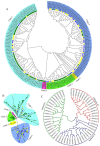Genome-Wide Identification, Characterization and Expression Patterns of the Pectin Methylesterase Inhibitor Genes in Sorghum bicolor
- PMID: 31561536
- PMCID: PMC6826626
- DOI: 10.3390/genes10100755
Genome-Wide Identification, Characterization and Expression Patterns of the Pectin Methylesterase Inhibitor Genes in Sorghum bicolor
Abstract
Cell walls are basically complex with dynamic structures that are being involved in several growth and developmental processes, as well as responses to environmental stresses and the defense mechanism. Pectin is secreted into the cell wall in a highly methylesterified form. It is able to perform function after the de-methylesterification by pectin methylesterase (PME). Whereas, the pectin methylesterase inhibitor (PMEI) plays a key role in plant cell wall modification through inhibiting the PME activity. It provides pectin with different levels of degree of methylesterification to affect the cell wall structures and properties. The PME activity was analyzed in six tissues of Sorghum bicolor, and found a high level in the leaf and leaf sheath. PMEI families have been identified in many plant species. Here, a total of 55 pectin methylesterase inhibitor genes (PMEIs) were identified from S. bicolor whole genome, a more detailed annotation of this crop plant as compared to the previous study. Chromosomal localization, gene structures and sequence characterization of the PMEI family were analyzed. Moreover, cis-acting elements analysis revealed that each PMEI gene was regulated by both internal and environmental factors. The expression patterns of each PMEI gene were also clustered according to expression pattern analyzed in 47 tissues under different developmental stages. Furthermore, some SbPMEIs were induced when treated with hormonal and abiotic stress. Taken together, these results laid a strong foundation for further study of the functions of SbPMEIs and pectin modification during plant growth and stress responses of cereal.
Keywords: PMEI; Sorghum bicolor; cell wall; cis-acting element; expression patterns; gene expression; gene structure; qRT-PCR.
Conflict of interest statement
The authors declare no conflict of interest.
Figures








References
Publication types
MeSH terms
Substances
LinkOut - more resources
Full Text Sources
Research Materials

